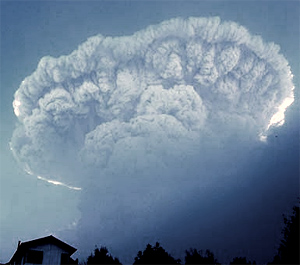Effects Of Volcanic Ash
A significant danger from volcanoes is the volcanic ash that can be ejected high into the atmosphere and cause severe local or regional damage, or even world wide longer term disruption.
Luckily, the majority of current and recent volcanic activity has not resulted in severe damage beyond local vicinities. But there are lots of sleeping giants out there that could potentially change the lives of populations well beyond the local. There is also a special category of volcanoes reserved specifically for those that would cause extreme damage, the super volcano.
Given the recent eruption of Iceland’s Eyjafjallajökull and the anticipated eruption of neighboring Katla, without regard for the category of the volcano let’s look at something that is common to all, but in varying degrees of impact… Volcanic Ash.
Volcanic Ash Composition
Volcanic Ash is made of tiny jagged hard pieces or particles of volcanic glass, rock, and minerals, and is very abrasive and somewhat corrosive.
What do volcanoes release into the atmosphere?
- Water Vapor (H2O) – no problem
- Carbon Dioxide (CO2) – same as what we exhale when we breathe, OK so far…
- Sulfur Dioxide (SO2) – Ok, smells like eggs, but can form into acid rain – not so good
- Hydrochloric Acid (HCI) – highly corrosive
- Hydrofluoric Acid (HF) – extremely corrosive
- Ash (jagged particles of volcanic glass, rock, and minerals) – see below…
Volcanic Ash Dangers
Infrastructure
- Volcanic Ash is HEAVY – Roof collapse of buildings when ash begins to reach about 4 inches depth (10 cm) for weaker structures and gets worse with depth. Danger zone depends entirely upon magnitude of eruption versus distance from ground zero and prevailing wind direction.
- Abrasive nature of ash will clog combustion engine filters or damage engines if operating within sufficient volcanic ash air density
Airliners
- Ash will sandblast the pilot’s window, fuselage, and clog sensors within seconds
- Ash will melt onto the turbines and parts of the combustion chamber of a jet engine causing stall or complete failure
- Regional airline hub closures if ash is identifiably dense enough to present a threat to air travel safety
- Lengthy airport closures affect regional and global economy
Food Supply
- Fluorine poisoning can lead to livestock death from eating grasses that are coated with fluorine affected ash
- Complete crop failure is likely in nearby zones that cover with ash
- Partial crop failure in regions, depending on severity of ash cover or quantity of ash entering into the stratosphere (10 – 50 km, 6 – 31 miles) which could reduce temperatures world wide for a period of months or even years depending on severity of eruption
Humans
- Respiratory effects upon inhaling abrasive ash particles below 10 microns, which is the smallest size that the nose and upper respiratory system can filter out before entering deep into the lungs
- Volcanic ash mixed with moisture in the lungs will turn to liquid cement, and if bad enough, will suffocate
- Inhalation of free silica could potentially lead to Silicosis— a fibrous (scarring) reaction of the lungs
- Eye damage if wearing contact lenses from ash abrasion on the surface of the eye if within ash zone (wear glasses instead!)
- Water supply pollution and crop damage from acid rain (rain washes out the acid from the volcanic ash particles in the atmosphere)
- Threat of regional starvation, again entirely depending on severity and ability of others to respond
Economy
- Local economy would likely be ruined
- Regional economy can be negatively affected quickly, if ash plume impacts the area
- Global economy will be affected if the regional impact is located within a strategic location, example being the global impact from a major Icelandic volcano affecting European geographies
- Global economy will be adversely affected if volcanic ash is exploded up high enough into the stratosphere to cause world wide climate change, cooling temperatures, and agriculture failures (higher food prices for starters…)
How does one prepare for a threat resulting from a significantly large eruption? Assuming it’s not a super volcano (which would require orders of magnitude greater level of readiness – but fortunately is very rare), the answer will depend on your exposure risk based on your geographical location. Only you know where you live, and can choose your best plan of insurance.
Check your financial exposure to possible related equities, always keep at least a minimum comfort level of food storage (a personal choice), and come to grips with the fact that we as humans are tiny in comparison with the power of earth’s forces.
Be prepared.
If you enjoyed this post, or topics of preparedness, consider subscribing to our blog RSS feed or Email notification of new posts on the Modern Survival Blog

